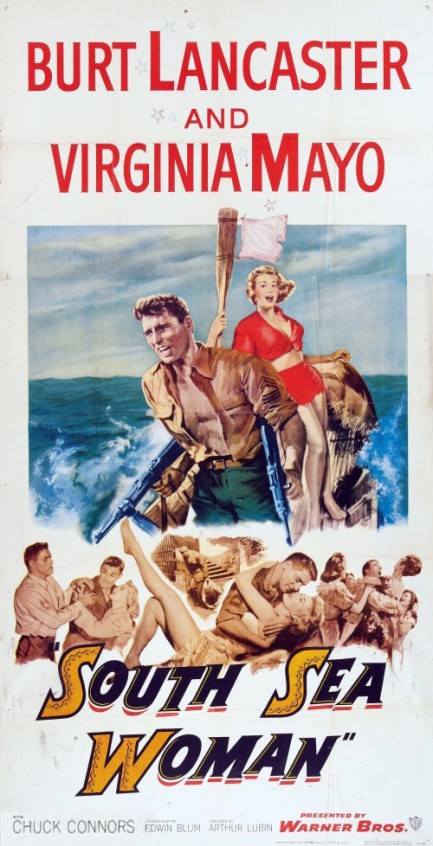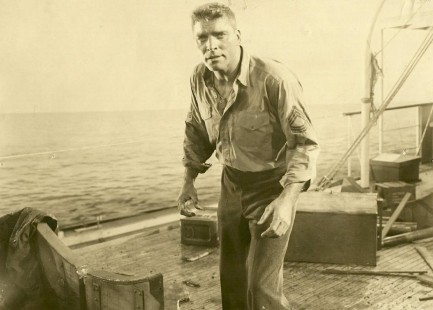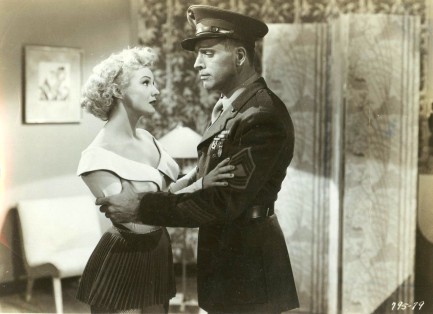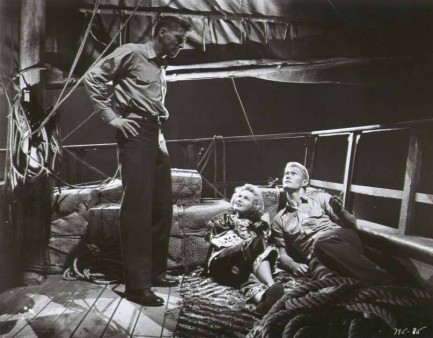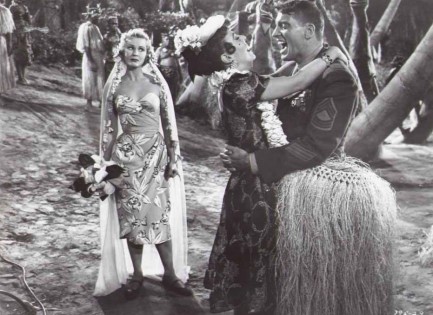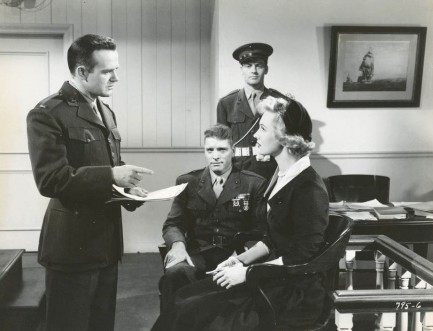 Every time she takes out a cigarette she barely survives a forest of fires. 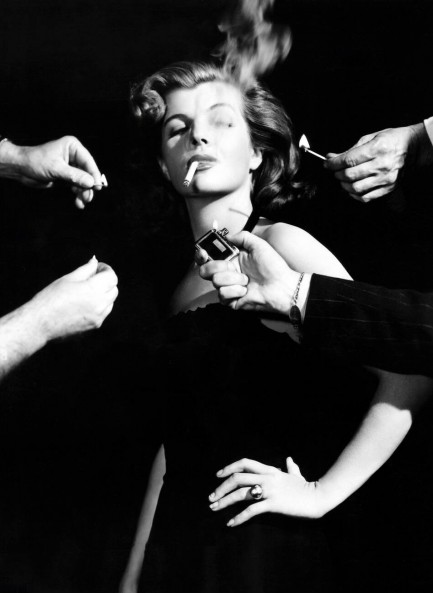
Above: an interesting of shot of French actress Corinne Calvet made in 1951 when she was filming the anti-communist thriller Peking Express. It was a remake of the 1932 film Shanghai Express starring Marlene Dietrich. Tough shoes to fill but Calvet was a major star in her day, and considered a major beauty. You can't see that in this photo, what with all the smoke, but you can in a shot we shared earlier, at this link.
 Sugawara gives the red light to wartime slavery. 
This blazingly colorful promo poster was made for the action movie Onna dorei-sen, known in English as Female Slave Ship, which is set during World War II and follows the adventures of a navy lieutenant played by Bunta Sugawara. The tale begins with him sent on a secret mission to obtain radar schematics to help salvage Japan's waning war fortunes, but unfortunately his plane is shot full of holes by a squadron of American F4Fs and he ends up in the drink. He's picked up by a Shanghai bound China boat, or slave ship, carrying twelve women meant to be auctioned to a gathering of Epsteins. Eleven of the women are prostitutes, but Rumiko, played by the lovely Utako Mitsuya, was tricked onto the boat. Naturally, she and Sugawara form an instant connection. Can he save her? You can be sure he'll try his best.
But just when you think Female Slave Ship is a straightforward white-knight-saves-damsel tale, the slave ship is attacked by pirates, and the women and Sugawara are suddenly at the mercy of the most ruthless band of unbathed thugs ever to steam the East China Sea. After some onboard drama the vessel lands, not in Shanghai but on a rocky Chinese coast where traffickers plan to brand and sell the women. This obviously can't stand, which means Buntawara must somehow throw sand in the gears. Why he's even alive at this point is a question. He's been nothing but trouble to the pirates, and the simplest solution would have been to toss him to the sharks. Failing to do that will be a costly and contusion making error.
We wanted to get away from Nikkatsu Studios' misogynistic roman pornos for a while and this effort from Shintoho Film fulfilled the requirement. Well, mostly. While generally tame, you'll rarely see so many women slapped around. But the treatment is meant to outrage. Mission accomplished. You will hate these traffickers. As for the movie overall, we suspect you'll like-not-love it. It's done in broad strokes, but as a sort of surf-to-turf soap opera it mostly works fine. Sugawara, who was soon to become a cinematic icon, has a charisma befitting his burgeoning status. And Yôko Mihara, already a big star at this point, is enjoyable playing a slippery slaver whose allegiances shift with the tides. She and Sugawara are worth seeing. Female Slave Ship premiered in Japan today in 1960.
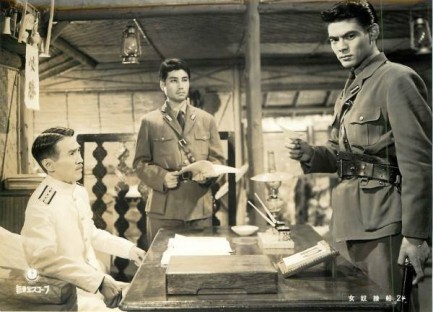 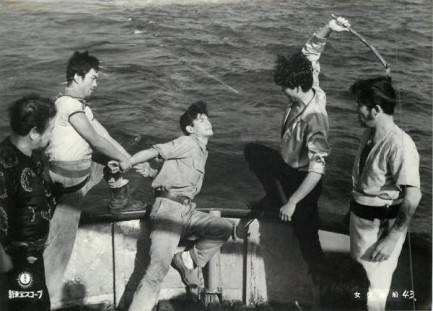 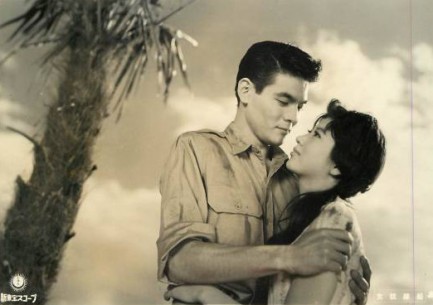 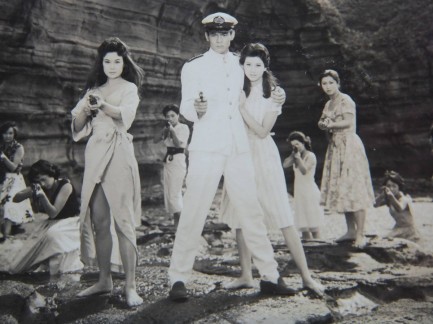 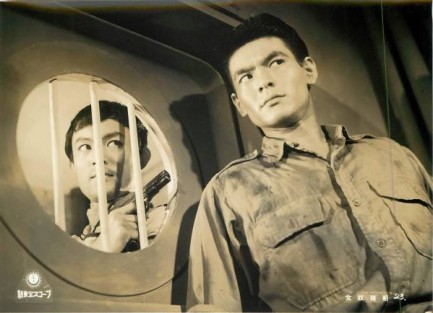 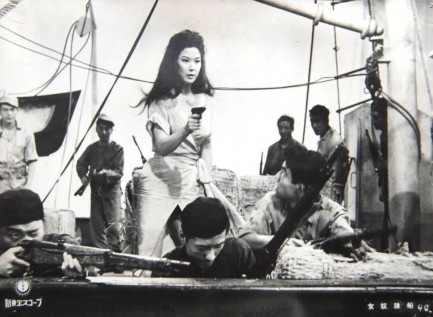 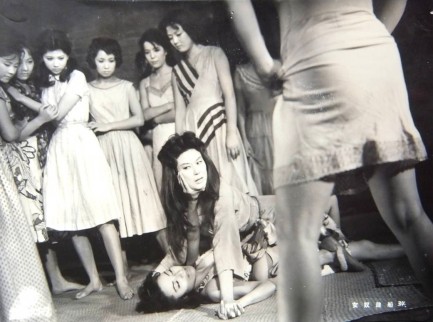
 Sure, I'll put the cigarette out. But I'll still be smoking. 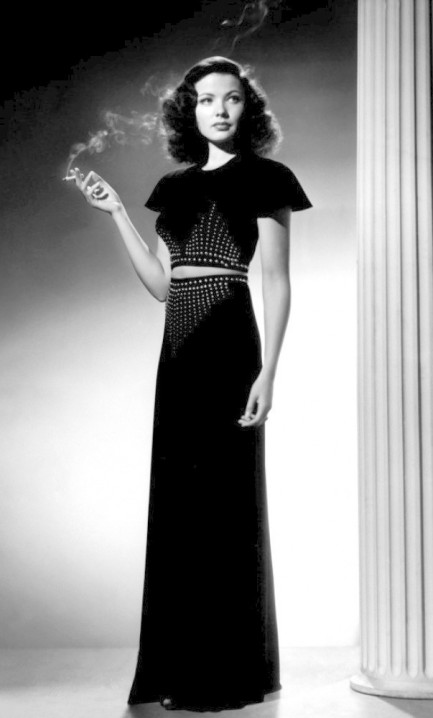
There are a few shots of U.S. actress Gene Tierney posing with the column you see behind her, but we like this one the best. It's usually attributed to her 1944 film noir Laura, but other people say it's from 1942's The Shanghai Gesture. Sharp-eyed film noir fans will remember that there's a column like this in Laura Hunt's apartment in Laura, but that isn't why the promo is from Laura. It's the hair. Tierney basically wore a pompadour in The Shanghai Gesture, and remember, these promos were almost always made with the subject in character. So this is from Laura, for sure. But the confusion is understandable, because Tierney was also photographed on this set for The Shanghai Gesture too. Check the photo below, note the hair, and note the dress—she wore that in The Shanghai Gesture, which you can prove by going here and seeing it worn in front of a Chinese themed backdrop. So the set above was used for Tierney twice, once in ’42, and once in ’44. She was hot both times.
 There are worse fates than being Shanghaied by Hayworth. 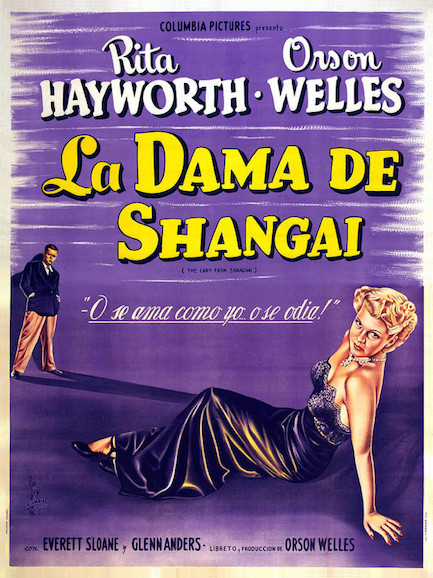
This beautiful poster was made for Argentina to promote the film noir The Lady from Shanghai, which starred Rita Hayworth and Orson Welles. There's no official Argentine premiere date, but since the movie reached Mexico in April 1948 and Uruguay in July 1948, it's a reasonable bet that it hit Argentina sometime during the summer of that year. Read a bit about the film here.
 Famed director ends up with too many cooks in his kitchen. 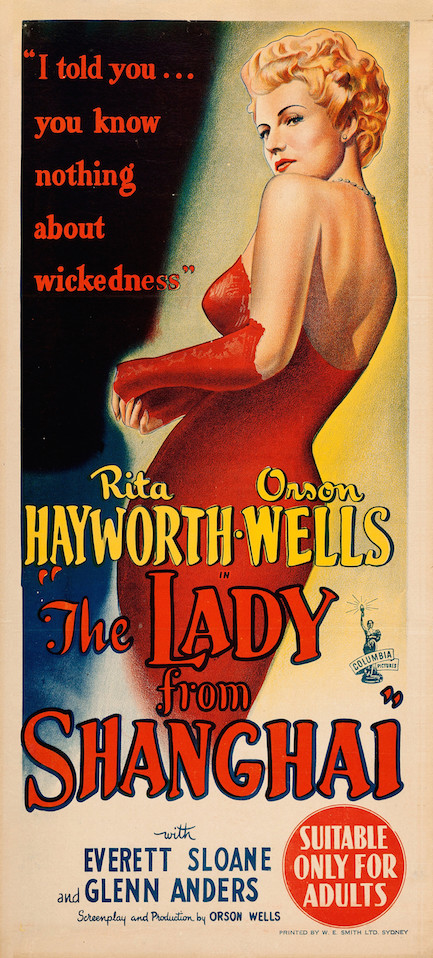
The film noir The Lady from Shanghai, starring Hollywood icons Rita Hayworth and Orson Welles, and directed by Welles, premiered in 1947 but reached Australia today in 1948, with this stunning promo poster having been distributed Down Under to help attract audiences. This film had amazing promos in many countries, some of which we'll show you later, and they all spelled Welles' last name correctly, which this one didn't. All the brilliant poster work around this movie is ironic, because Harry Cohn, who was the shot-caller at Columbia Pictures, hated it. He even shelved the flick for a year while he waited for what he deemed to be the best date to release it. When he finally did, what audiences saw was a radically altered version of Welles' original edit.
What did Cohn specifically hate about the film? Foremost there was its length, which was 155 minutes, and which Cohn ordered condensed, with the final running time coming to a mere 88 minutes. He also felt Hayworth didn't have enough close-ups, so he had those shot during extensive re-takes. Hayworth also didn't have a song, which was standard for film noir leading ladies, so Cohn had a number added and had Hayworth's voice dubbed. He hated the lighting, which he felt was a negative result of Welles choosing location work over controlled studio conditions. And he especially hated that Hayworth had agreed to chop off her auburn hair and dye it platinum. The list goes on but you get the point—clashing creative visions. Nothing new in Hollywood.
The Lady from Shanghai finds Welles playing a typical film noir schmo who falls in love with a femme fatale and is drawn into a murder plot. Other familiar film noir tropes include a trip to Mexico (not in the original novel by Sherwood King) and a tense court showdown. But what's decidedly uncommon here is Welles' visual mastery of the cinematic form. His abilities there have been exhaustively discussed and are in no way overrated, but visuals are only part of the filmic equation. There's also narrative pace and story cohesion and emotional tone, and those are areas where the movie runs into a bit of trouble. Since Welles' cut was so much longer (and presumably better) than what has ever been seen by the public, many of those problems were probably introduced by clumsy third parties.
But we can only judge what we see. Since all that missing footage is thought to have been destroyed, it takes a major leap of faith to see a masterpiece in what Welles himself thought was a diced up travesty of his original vision. We don't understand how anyone can truly revere him, yet disregard his artistic opinion. But that's exactly what some contemporary film writers do. We recently read a review that discussed how well the visuals and music work together, but Welles hated the score, which he had no control over and which lacked the subtlety he wanted it to have. We suggest that a critic is trying way too hard when they lavish praise upon a director for something he didn't even do. Welles was a genius—agreement on that point is universal. But even geniuses are not so magical that their abilities can overcome the artistic myopia and careless scissors of studio heads.
The Lady from Shanghai received mixed reviews when released, and ultimately, those reviews strike us as fair. There's plenty here worth seeing, particularly the ravishing Hayworth and nice location work in Acapulco and Sausalito, and of course Welles makes shots like Steph Curry makes 3s. But even so, the final result is good but not great. Not a failure, but not a top notch film noir. Calling The Lady from Shanghai one of the best of the genre is just unfair to the many, many great noirs that were made. Still, if you're a noir fan you should see it. And we're confident you'll enjoy it like we did. On the other hand, if you've never watched a film noir and this happens to be first one you see, we can easily picture you giving a shrug and drifting away from the genre, never to return. 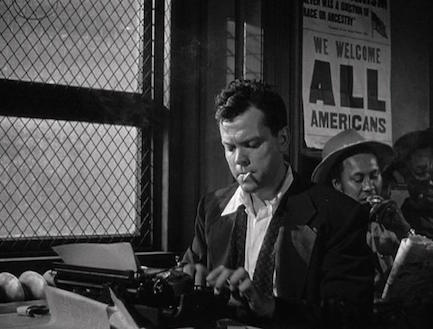 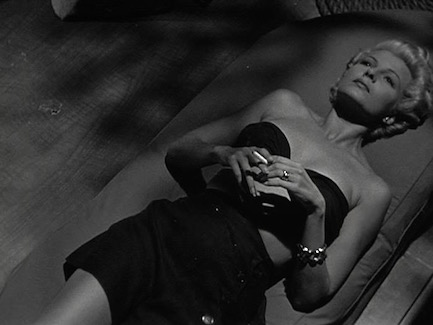 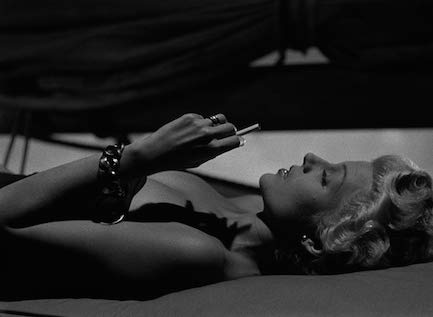 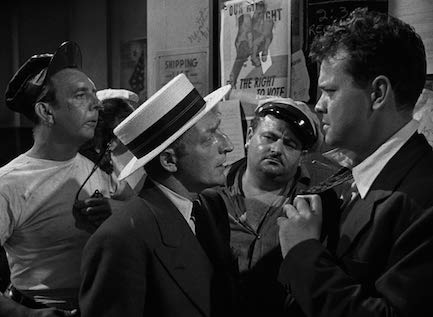 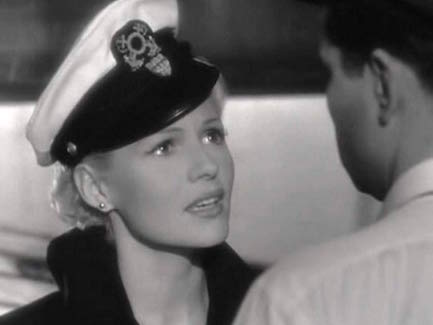 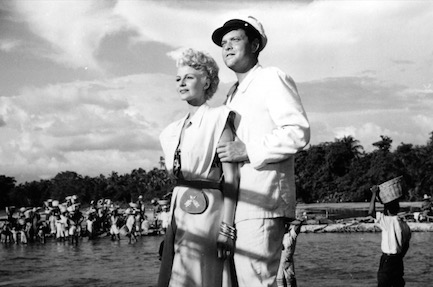 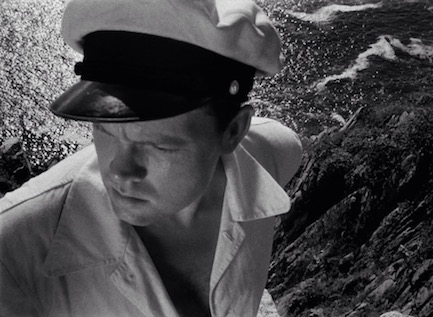 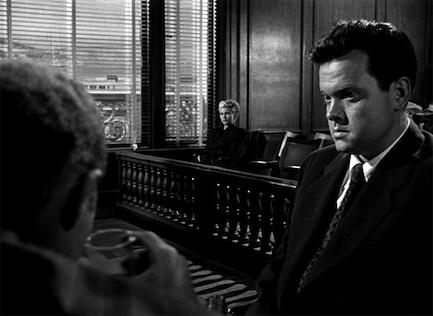 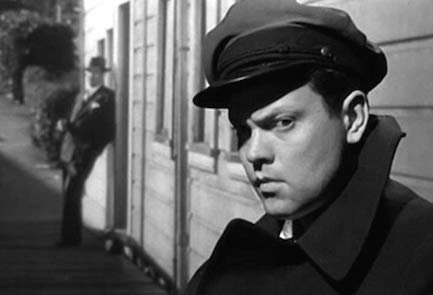 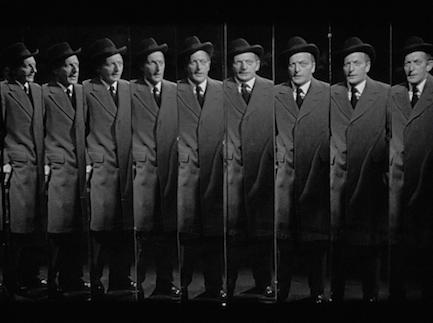
 Is there anything sweeter than a beautiful movie palace? 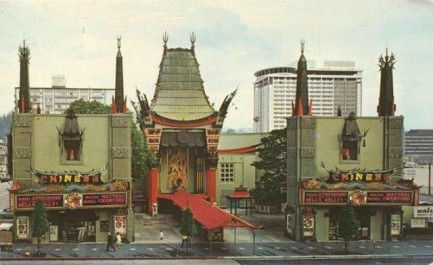
You probably recognize Grauman's Chinese Theatre, in Los Angeles. These days it's called TCL Chinese Theatre, because it's owned and operated by TCL Corporation—based in China, ironically. Since we write so often about movies we thought it appropriate to discuss the beautiful buildings in which the films were exhibited. Back in the day these were usually purpose-built structures, though some did split duty for stage productions and concerts. While many of these old palaces survive, nearly all surviving vintage cinemas in the U.S. were under threat at some point. Generally, if they hadn't been given historic protection they wouldn't be upright today.
Other times, if a city was poor, real estate costs didn't rise and old buildings stood unthreatened, usually idle. This happened often in the American midwest, where movie houses were neglected for decades before some were resurrected amid downtown revitalizations. It sometimes happens in Latin America too, although occasionally the formula fails. For example, Cartagena's majestic and oft photographed landmark Teatro Colón, located in the historic section of Colombia's most popular coastal tourist city, was torn down fewer than six months ago to make way for a Four Seasons Hotel.
Some of the cinemas below are well known treasures, while others are more unassuming places. But even those lesser known cinemas show how much thought and work was put into making moviegoing a special experience. The last photo, which shows the Butterfly Theatre in Milwaukee, exemplifies that idea. The façade is distinguished by a terra cotta butterfly sculpture adorned with light bulbs. As you might guess, many of the most beautiful large cinemas were in Los Angeles, which means that city is well represented in the collection. Enjoy.
 Paramount Theatre, Oakland (operational). Paramount Theatre, Oakland (operational).
 Cine Maya, Mérida (demolished). Cine Maya, Mérida (demolished).
 The Albee Cinema, Cincinnati (demolished) The Albee Cinema, Cincinnati (demolished)
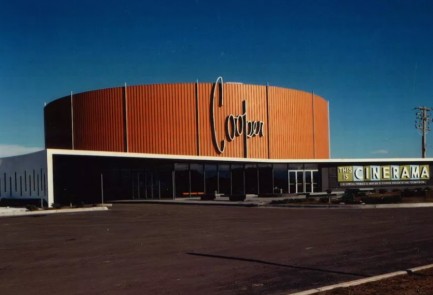 Cooper Theatre, Denver (demolished). Cooper Theatre, Denver (demolished).
 Paras Cinema, Jaipur (operational). Paras Cinema, Jaipur (operational).
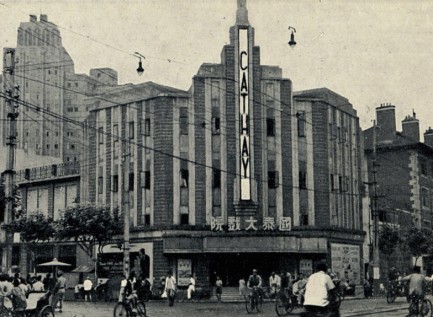 Cathay Cinema, Shanghai (operational). Cathay Cinema, Shanghai (operational).
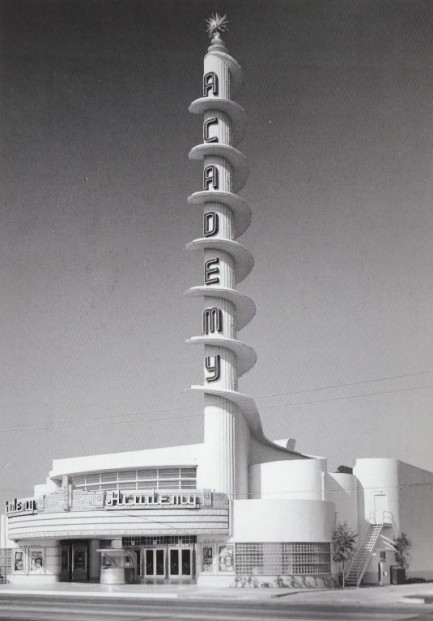 Academy Theatre, Los Angeles (operational). Academy Theatre, Los Angeles (operational).
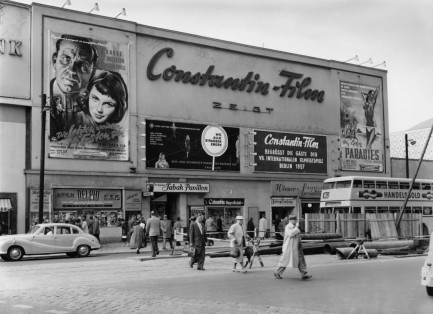 Charlottenburg Filmwerbung, Berlin (demolished). Charlottenburg Filmwerbung, Berlin (demolished).
 Pacific's Cinerama Theatre, Los Angeles (operational). Pacific's Cinerama Theatre, Los Angeles (operational).
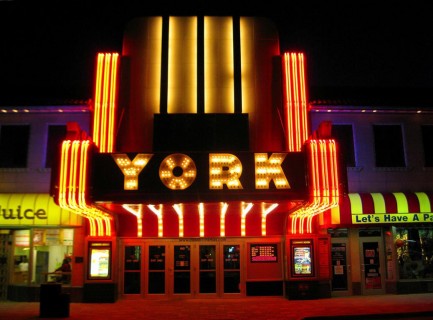 York Theatre, Elmhurst (operational). York Theatre, Elmhurst (operational).
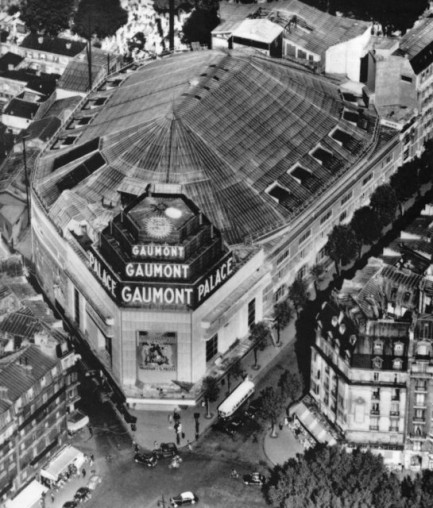 La Gaumont-Palace, Paris (demolished). La Gaumont-Palace, Paris (demolished).
 Essoldo Cinema, Newcastle (demolished). Essoldo Cinema, Newcastle (demolished).
 Théâtre Scala, Strasbourg (operational). Théâtre Scala, Strasbourg (operational).
 Teatro Colón, Cartagena (demolished in 2018). Teatro Colón, Cartagena (demolished in 2018).
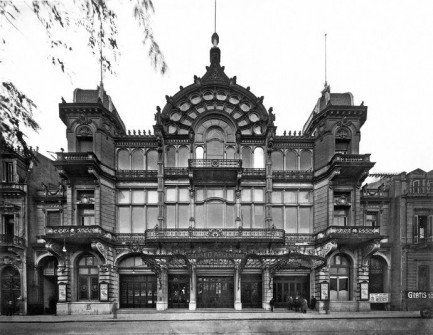 Teatro Coliseo Argentino, Buenos Aires (demolished). Teatro Coliseo Argentino, Buenos Aires (demolished).
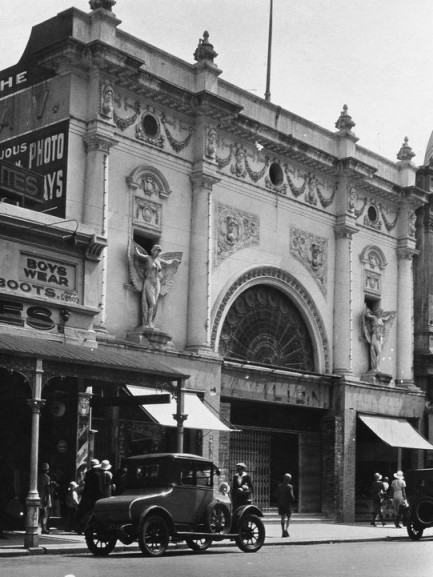 Pavilion Theater, Adelaide (demolished). Pavilion Theater, Adelaide (demolished).
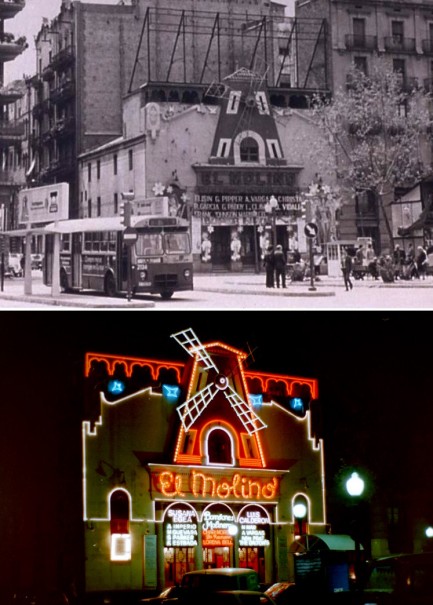 El Molino Teatro, Barcelona (operational). El Molino Teatro, Barcelona (operational).
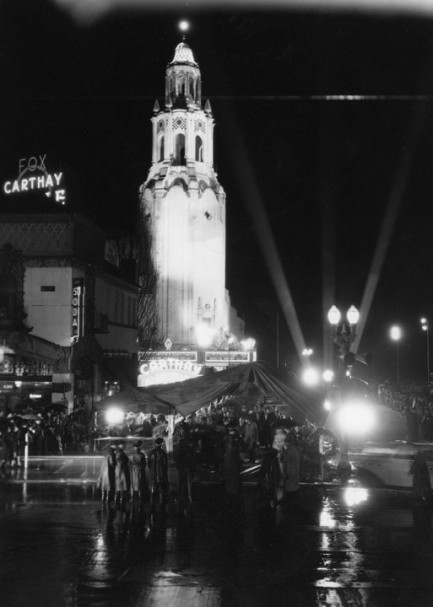 Fox Carthay Theatre, Los Angeles (demolished). Fox Carthay Theatre, Los Angeles (demolished).
 Kino Rossiya Teatr, Moscow (operational). Kino Rossiya Teatr, Moscow (operational).
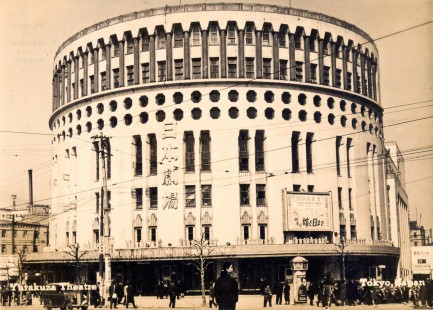 Nippon Gekijo, aka Nichigeki, Tokyo (demolished). Nippon Gekijo, aka Nichigeki, Tokyo (demolished).
 Cine Impala, Namibe (operational). Cine Impala, Namibe (operational).
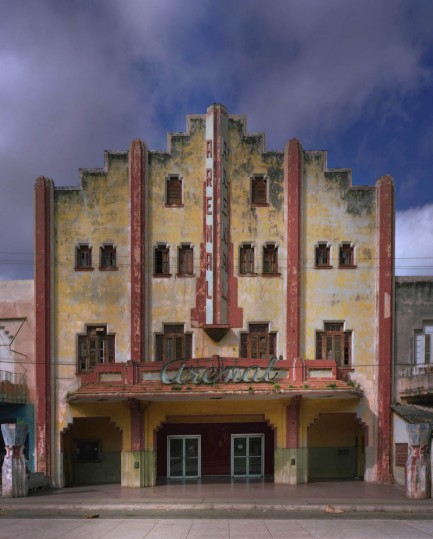 Cine Arenal, Havana (operational). Cine Arenal, Havana (operational).
 Teatro Mérida, Mérida (operational, renamed Teatro Armando Manzanero). Teatro Mérida, Mérida (operational, renamed Teatro Armando Manzanero).
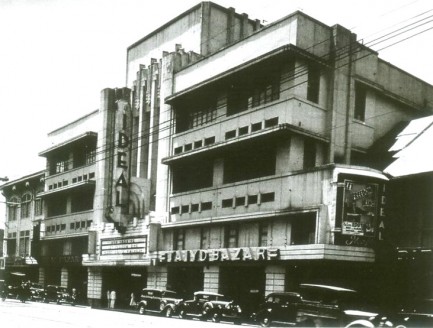 Ideal Theater, Manila (demolished). Ideal Theater, Manila (demolished).
 Odeon Cinema, London (semi-demolished, converted to apartments). Odeon Cinema, London (semi-demolished, converted to apartments).
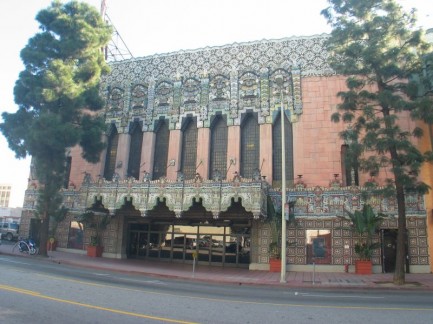 Mayan Theatre, Los Angeles (operational). Mayan Theatre, Los Angeles (operational).
 Rex Cinema, Port au Prince (being restored). Rex Cinema, Port au Prince (being restored).
 Urania Kino, Vienna (operational). Urania Kino, Vienna (operational).
 Tampa Theatre, Tampa (operational). Tampa Theatre, Tampa (operational).
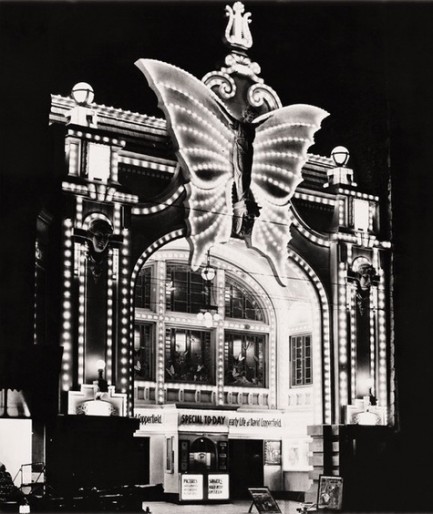 The Butterfly Theater, Milwaukee (demolished). The Butterfly Theater, Milwaukee (demolished).
 That was interesting. Next time can we just do it the normal way? 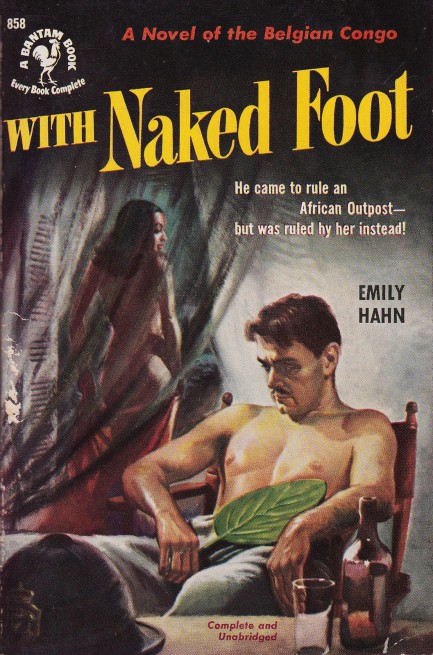
There's no festish sex or podophilia in With Naked Foot. This is actually a serious novel about whites coming to ruin in Africa, which is a crowded literary niche, but one in which Emily Hahn carved out an important place for herself. In fact, maybe the adjective “Hahnesque” should be used alongside “Hemingwayesque.” This is a person who wrote fifty-four books and more than two hundred articles and short stories, whose works were significant in romanticizing Africa and Asia for western readers, who lived in Florence and London in the mid-1920s, traveled to the Belgian Congo where she worked for the Red Cross, lived with a pygmy tribe for two years, crossed Central Africa alone on foot, and journeyed to Shanghai where she taught English for three years while becoming acquaintances with political powerhouses the Soong Sisters and the Chinese poet Zau Sinmay. With Naked Foot is, therefore, unusually well informed. It revolves around a beautiful Congolese girl named Mawa whose relationships with various lustful white men bring disaster. The reviews were rapturous, though some critics protested that it was too focused on sex. That's never a complaint you'll hear from us, though some of the usual flaws of mid-century racial fiction are evident. The cover art on this Bantam paperback was painted by an unknown, and the copyright is 1951.
 I shot my alarm clock. After years of abuse it was long overdue. 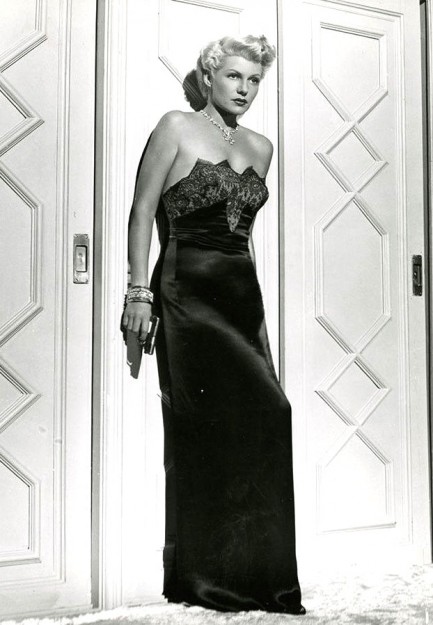
Above, a nice image of a nightgown clad, gun accessorized Rita Hayworth in her rare platinum blonde incarnation. The photo was made as a promo for her film noir The Lady from Shanghai, 1947.
 Please let me go! I’m not even in this book! 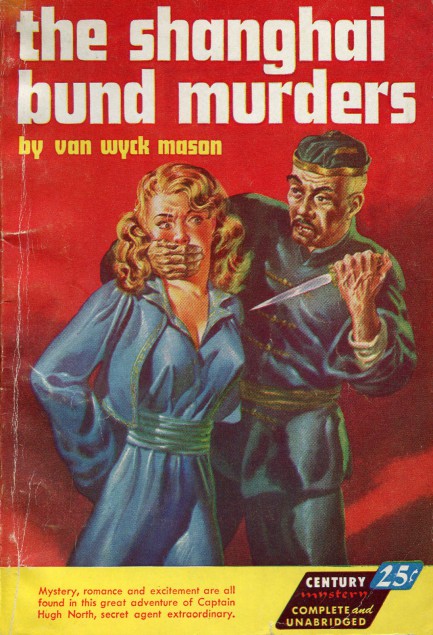
Originally published in 1933, with this Century Publications paperback appearing in 1946, Van Wyck Mason’s The Shanghai Bund Murders was seventh in a series of twenty-six mostly similarly titled thrillers such as The Hongkong Airbase Murders, The Sulu Sea Murders, and—no one-trick-pony Mr. Mason—The Budapest Parade Murders, because murder happens even outside Asia. All of these starred his spy creation Hugh North, and here Hugh finds a coin—previously carried by an agent who suffered an early demise—that is engraved with a coded message about Chinese military secrets. You get pro forma anti-commie stuff, but the real villains here are western gunrunners. The excellent cover art, which is not related to the text, is by Malcolm Smith.

|
 |

The headlines that mattered yesteryear.
1939—Holiday Records Strange Fruit
American blues and jazz singer Billie Holiday records "Strange Fruit", which is considered to be the first civil rights song. It began as a poem written by Abel Meeropol, which he later set to music and performed live with his wife Laura Duncan. The song became a Holiday standard immediately after she recorded it, and it remains one of the most highly regarded pieces of music in American history. 1927—Mae West Sentenced to Jail
American actress and playwright Mae West is sentenced to ten days in jail for obscenity for the content of her play Sex. The trial occurred even though the play had run for a year and had been seen by 325,000 people. However West's considerable popularity, already based on her risque image, only increased due to the controversy. 1971—Manson Sentenced to Death
In the U.S, cult leader Charles Manson is sentenced to death for inciting the murders of Sharon Tate and several other people. Three accomplices, who had actually done the killing, were also sentenced to death, but the state of California abolished capital punishment in 1972 and neither they nor Manson were ever actually executed. 1923—Yankee Stadium Opens
In New York City, Yankee Stadium, home of Major League Baseball's New York Yankees, opens with the Yankees beating their eternal rivals the Boston Red Sox 4 to 1. The stadium, which is nicknamed The House that Ruth Built, sees the Yankees become the most successful franchise in baseball history. It is eventually replaced by a new Yankee Stadium and closes in September 2008.
|

|
|

It's easy. We have an uploader that makes it a snap. Use it to submit your art, text, header, and subhead. Your post can be funny, serious, or anything in between, as long as it's vintage pulp. You'll get a byline and experience the fleeting pride of free authorship. We'll edit your post for typos, but the rest is up to you. Click here to give us your best shot.

|
|













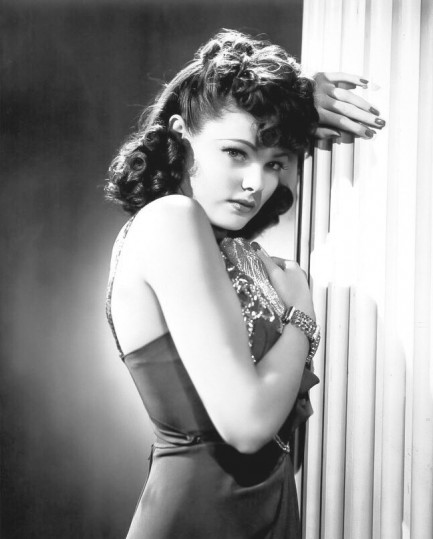
















 Paramount Theatre, Oakland (operational).
Paramount Theatre, Oakland (operational). Cine Maya, Mérida (demolished).
Cine Maya, Mérida (demolished). The Albee Cinema, Cincinnati (demolished)
The Albee Cinema, Cincinnati (demolished) Cooper Theatre, Denver (demolished).
Cooper Theatre, Denver (demolished). Paras Cinema, Jaipur (operational).
Paras Cinema, Jaipur (operational). Cathay Cinema, Shanghai (operational).
Cathay Cinema, Shanghai (operational). Academy Theatre, Los Angeles (operational).
Academy Theatre, Los Angeles (operational). Charlottenburg Filmwerbung, Berlin (demolished).
Charlottenburg Filmwerbung, Berlin (demolished). Pacific's Cinerama Theatre, Los Angeles (operational).
Pacific's Cinerama Theatre, Los Angeles (operational). York Theatre, Elmhurst (operational).
York Theatre, Elmhurst (operational). La Gaumont-Palace, Paris (demolished).
La Gaumont-Palace, Paris (demolished). Essoldo Cinema, Newcastle (demolished).
Essoldo Cinema, Newcastle (demolished). Théâtre Scala, Strasbourg (operational).
Théâtre Scala, Strasbourg (operational). Teatro Colón, Cartagena (demolished in 2018).
Teatro Colón, Cartagena (demolished in 2018). Teatro Coliseo Argentino, Buenos Aires (demolished).
Teatro Coliseo Argentino, Buenos Aires (demolished). Pavilion Theater, Adelaide (demolished).
Pavilion Theater, Adelaide (demolished). El Molino Teatro, Barcelona (operational).
El Molino Teatro, Barcelona (operational). Fox Carthay Theatre, Los Angeles (demolished).
Fox Carthay Theatre, Los Angeles (demolished). Kino Rossiya Teatr, Moscow (operational).
Kino Rossiya Teatr, Moscow (operational). Nippon Gekijo, aka Nichigeki, Tokyo (demolished).
Nippon Gekijo, aka Nichigeki, Tokyo (demolished). Cine Impala, Namibe (operational).
Cine Impala, Namibe (operational). Cine Arenal, Havana (operational).
Cine Arenal, Havana (operational). Teatro Mérida, Mérida (operational, renamed Teatro Armando Manzanero).
Teatro Mérida, Mérida (operational, renamed Teatro Armando Manzanero). Ideal Theater, Manila (demolished).
Ideal Theater, Manila (demolished). Odeon Cinema, London (semi-demolished, converted to apartments).
Odeon Cinema, London (semi-demolished, converted to apartments). Mayan Theatre, Los Angeles (operational).
Mayan Theatre, Los Angeles (operational). Rex Cinema, Port au Prince (being restored).
Rex Cinema, Port au Prince (being restored). Urania Kino, Vienna (operational).
Urania Kino, Vienna (operational). Tampa Theatre, Tampa (operational).
Tampa Theatre, Tampa (operational). The Butterfly Theater, Milwaukee (demolished).
The Butterfly Theater, Milwaukee (demolished).
